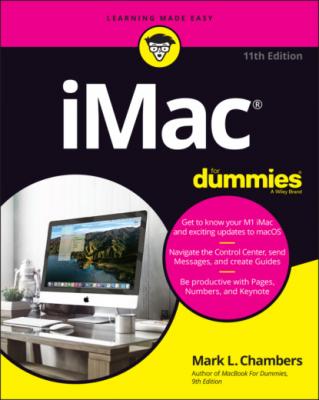iMac For Dummies. Mark L. Chambers
Чтение книги онлайн.
Читать онлайн книгу iMac For Dummies - Mark L. Chambers страница 12
 href="#fb3_img_img_81d9c680-a2c8-53a4-a8fd-995657195259.png" alt="Technicalstuff"/> LED and Retina screens use far less electricity than their antique CRT ancestors, and they emit practically no radiation (less, in fact, than even the LCD screens that Apple once used).
href="#fb3_img_img_81d9c680-a2c8-53a4-a8fd-995657195259.png" alt="Technicalstuff"/> LED and Retina screens use far less electricity than their antique CRT ancestors, and they emit practically no radiation (less, in fact, than even the LCD screens that Apple once used).
All these displays offer a widescreen aspect ratio (the screen is considerably wider than it is tall), which augurs well for those who enjoy watching movies. (A favorite editor of mine loves it when I use the antique word augur, meaning to predict or foretell.) For example, the 27″ iMac boasts a whopping 5120 × 2880 resolution.
FIGURE 1-1: The charismatic form of your aluminum iMac.
The keyboard and mouse
Hey, here’s something novel for our favorite all-in-one computer — something external (outside the computer’s case). Gotta have a keyboard and mouse (or trackpad), right? And you gotta love the options with iMac: You’ll go nomadic … um, that is, wireless and free.
The iMac comes standard with a truly 21st-century combo of an Apple wireless Magic keyboard and a Magic Mouse 2. The M1 iMac can also be ordered with a Touch ID keyboard, which can read your fingerprint for security. You can also configure your new iMac with an expanded keyboard that includes a numeric keypad. (If you eschew the mouse as a pointing device, the Magic Trackpad 2 is also available when ordering a new iMac for $50 more.)
The Magic input duo lets you sit back and relax with your keyboard in your lap and without being tied down by a cord. (Say it with me: “Death to cords, death to cords.”) Just stay within about 30 feet of your iMac screen, and sweet freedom is yours. You can also feel safe using these wireless peripherals because they offer secure, 128-bit, over-the-air encryption, which helps keep sensitive information safe while you type and click away. One downside of the wireless keyboard, though: Unlike older wired keyboards, the wireless model doesn’t include any USB ports, and you will need a supply of batteries. (Go rechargeable!)
The keyboard layout is a particular favorite of mine because from here:
You can either control the sound volume (using the volume control buttons F11 and F12) or mute all that noise (using the Mute button F10).
Mission Control and Launchpad — two outstanding features of Monterey that you find out about later in the book — are each available with a single keystroke.
A handy-dandy Media Eject key lets you eject a CD or DVD (if you have an external optical drive).
Yes, your computer has a foot … just one
You and I — normal human beings — would say that the iMac is supported by a sturdy aluminum stand, but Apple calls it a foot. The foot lets you tilt the iMac panel up and down for the best viewing angle. Most important, though, the foot minimizes the computer’s desk space requirements (or its footprint). (Engineers … sheesh.) And yes, that foot is perfectly balanced and quite stable, so there’s no danger of your treasured aluminum supercomputer taking a dive.
If you decide to get really snazzy and mount your older iMac Pro to the wall, you can remove the foot and install the VESA mounting adapter (available separately for about $80). You can use any VESA standard mounting bracket on your wall, too. You can be positioned within 30 feet or so of your wall-mounted iMac Pro with a wireless Apple keyboard and mouse (or trackpad). Of the previous iMac generation, only the iMac Pro can use a VESA mount — however, the new 24″ M1 iMac can be ordered from Apple with a built-in VESA adapter instead of a foot.
Hey, Hewlett-Packard or Dell, can you mount one of those monolithic desktop PCs to the wall? I think not.
Food for your ears
A machine this nice had better have great sound, and the iMac doesn’t disappoint. You have a couple of options for iMac audio:
The 21.5″ Intel iMac sports built-in stereo speakers (and a microphone to boot). The 27″ Intel iMac raises the bar with stereo speakers and three microphones. And not to be outdone, the 24″ M1 iMac delivers a whopping six speakers and three microphones!
Built-in ports connect your iMac audio to either:More powerful (and more expensive) external speaker systemsA set of headphonesA home stereo system
You can also use wireless Bluetooth speakers with your iMac.
The power cable
Sorry, but you can’t get a wireless power system … yet. (Apple’s working hard on that one.) With the wireless keyboard and mouse/trackpad setup, though, the power cable is actually the only required cable that you need to run your computer! Now, that’s sassy.
The power button
Yep, you have one of these, too. It’s on the back of the case. (If you’re looking at the screen, it’s at the lower-left corner.)
Those holes are called ports
Our next stop on your tour of Planet iMac is Port Central — that row of holes on the back of your computer (see Figure 1-2). Each port connects a different type of cable or device, allowing you to easily add all sorts of extra functionality to your computer.
One of the holes is an exception to the Rule of Ports: The iMac’s SDXC card slot accepts the same type of SD memory cards as most of today’s digital cameras and video cameras. (In other words, that hole is not for connecting a cable; you insert the card instead.) The SDXC slot appears as a tiny horizontal slot on the Intel iMacs.